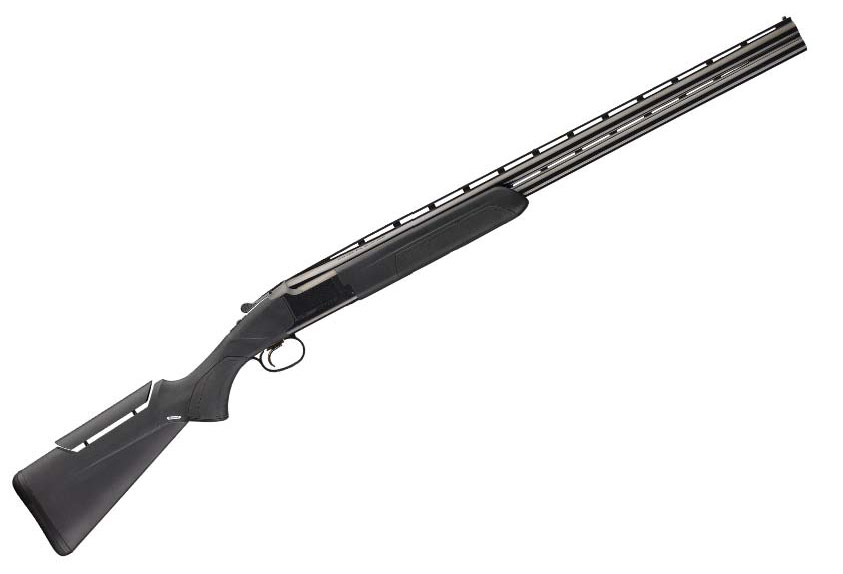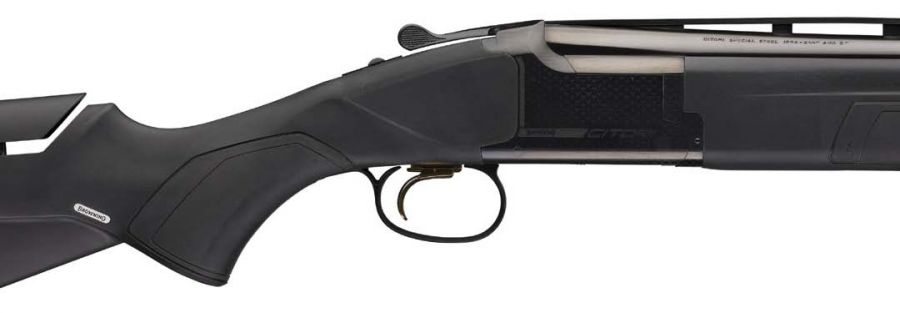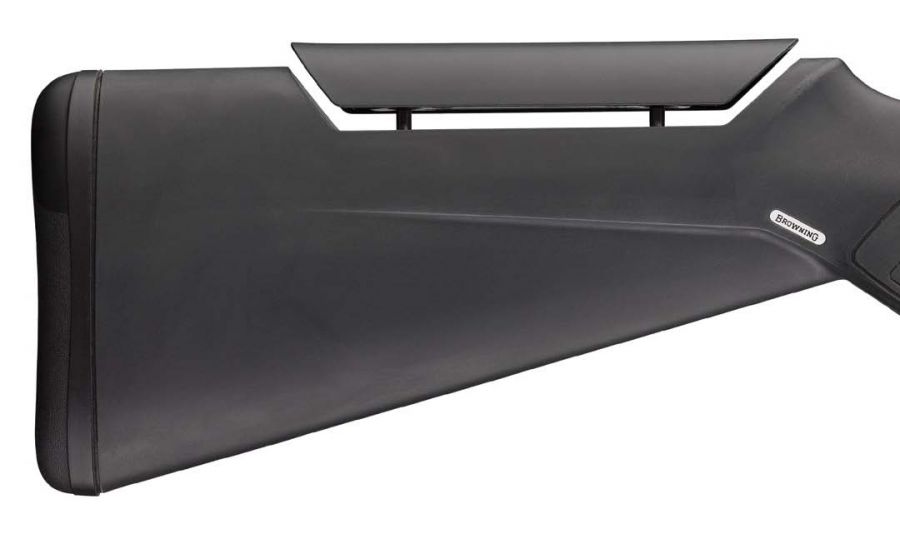



In 2023, the Browning Citori celebrated its 50th birthday. The Browning Citori was introduced in 1973 as a more affordable version of the highly successful Browning Superposed. Since 1973 the Browning Citori has been extremely successful for Browning — far surpassing the company’s initial expectations of this model.
The Browning Citori is available in a multitude of combinations of gauge, barrel length and stock configurations. While I do not know for sure, I would not hesitate to bet the Browning Citori has taken down more clay targets and birds in the field than any other over/under model. One of Browning’s highlights for the 2023 SHOT Show was the Browning Citori Composite. Browning was seeking to blend the dependability and reliability of the Citori model with the ruggedness, toughness and versatility of a composite.
I was really excited to undertake this gun test/review as I had not done one on a shotgun with a composite stock. Some of the advantages of a composite stock are they are lighter in weight, not affected by changes in temperature or humidity and extremely durable. I have many friends who believe these advantages make such a shotgun outstanding for hunting waterfowl as well as breaking clay targets.
With this being a Browning Citori, assembly of the shotgun was very straightforward, going together like most over/under shotguns do. The lighter weight of the composite stock and forearm was quite evident the moment I picked them up out of the Browning box they came in. Upon assembling the Browning Citori Composite with 28″ barrels, the total weight of the shotgun was 7 lbs., 6 oz. (11 oz. lighter than the Citori CX with 28″ barrels).
The Browning Citori Composite comes standard with an adjustable comb. This adjustable comb adjusts for height only using an Allen wrench to turn a screw embedded in the back of the top of the recoil pad. The Browning Citori Composite was shipped to me with the stock in the lowest position. Upon mounting it, I was looking at the top lever and not seeing the rib. Eight turns of the screw in the back of the top of the recoil pad, and I was looking down the rib such that the small white middle bead was halfway up the ivory-colored Bradley-style front bead. I had hoped this stock height would give me something close to a 55/45 Point Of Impact (POI).
The Browning Citori Composite has a trigger which can be positioned in three locations on a ½” rail, so the Length Of Pull (LOP) can be adjusted to the shooter’s preferred length. When I received the Browning Citori Composite, the trigger was set in the middle of the rail and the LOP was 14¾”. I prefer to shoot a LOP of 14½”, so moving the trigger back a ¼” with the Allen wrench took less than 30 seconds to make this adjustment. The Browning Citori Composite uses an inertia-trigger mechanism and came from the factory with a trigger pull of 3.75 pounds on both barrels. The barrels have ejectors which easily threw the snap caps I was using over my shoulder.
To select which barrel fires first, this shotgun has a barrel selector which sits just behind the top lever and uses the letters ‘U’ to indicate the bottom barrel will fire first and the letter ‘O’ to indicate the top barrel will fire first. Switching between the two involves pulling back on the selector and moving it left or right, so the correct letter shows. When the barrel selector is pulled back, the letter ‘S’ will show to designate the safety is engaged. The safety on the Browning Citori Composite is manual, such that it will not automatically engage each time the shotgun is opened.
The recoil pad on the Browning Citori Composite is black rubber of medium hardness and has a very slight concave curve to it. This is Browning’s new Inflex Technology recoil pad, which according to their website, has been designed to be the most recoil-absorbing pad that guides the comb down and away from the shooter’s cheek for greater shooting comfort. The composite stock does not have a palm swell and uses rubber molding (instead of checkering) to improve grip on both the pistol grip and forearm. The composite-to-metal finish is excellent with no gaps, edges or looseness.
The receiver of the Browning Citori Composite is blued, which very nicely stands out against the gray of the composite stock and forearm. The name “Citori” is written on both sides of the receiver, and the name “Browning” is written on the bottom of the receiver.
Atop the blued 28″ non-ported over/under barrels is a non-adjustable rib which is tapered from 3/8″ at the receiver to 5/16″ at the muzzle. Between the two 28″ barrels are ventilated side ribs to assist with barrel cooling. The Browning Citori Composite comes with three Invector-Plus chokes: Full, Modified and Improved Cylinder. These chokes are 2.4″ in total length and flush with the end of the barrels. The Browning Citori Composite’s barrels are back-bored and have a bore diameter of .742.
The forearm of the Browning Citori Composite is also composite and uses the Deeley & Edge release mechanism. The shape of the forearm is best described as a ‘slim beavertail’ having no finger grooves on the top edge.
After arriving at Colorado Clays Shooting Park in Brighton, Colorado, I headed straight to the patterning board and parked myself 15 yards back from the patterning board. Using the Modified choke in the bottom barrel, I took three shots with Winchester heavy 8s. My assumption was correct. Moving the comb up in such a way that the small white middle bead was halfway up the ivory-colored Bradley-style front bead put the bulk of the pattern 1½” above my aiming point. Moving the Modified choke to the top barrel (and using three more shotshells from the same box) gave me the same POI of 55/45. Moving myself 40 yards back from the patterning board, I fired three shots from the top barrel (Modified choke) and reviewed the pattern for distribution. What I saw was a pattern which was very uniform and did not have holes/gaps or clumping within the 30″ diameter circle. Being satisfied with what I saw, I headed to the trap field.
Starting at Post 3 at 16 yards, I missed my first target out because I forgot I was shooting a shotgun with a 55/45 POI (and not my usual 80/20 trap gun). At the end of the 25-target round, I had a score of 23, having missed a hard right by also shooting under it. With the Improved Cylinder choke in the bottom barrel and the Modified choke in the top barrel, I would switch every five shots. Since the POI was the same, the only noticeable difference was how hard the target was broken. With the Improved Cylinder, the target was broken into pieces and with the Modified choke it was crushed.
My overall impression of the Browning Citori Composite was very favorable. I was concerned that being very lightweight because of the composite stock that it would have significant felt recoil with the heavy 8 target loads. Just the opposite turned out to be true. The felt recoil was slightly less than heavier shotguns using the same ammunition. I believe the reason for this was that the technology in the Inflex Technology recoil pad was doing its job.
I met my friend Ross at Colorado Clays to do some shooting. Ross was in the middle of moving, and all of his shooting stuff was buried away, so I offered to let him shoot the Browning Citori Composite and let me know what he thought. Ross is the host of the “Ross Kaminsky Show” which is a morning talk show on radio station KOA in Denver, Colorado, and he is an avid rifle and pistol shooter. Ross shot skeet in a league years ago when he lived in Chicago and has been wanting to get better at sporting clays for quite some time. He is approximately the same height and weight as myself, so the way I had positioned the comb on the Browning Citori Composite gave him the same sight picture I had. This would allow both of us to use the Browning Citori Composite when shooting sporting clays.
With Ross’ background in skeet shooting, we decided to warm-up by shooting some skeet targets before going out on the sporting clays course with the Browning Citori Composite. Ross and I shot singles targets on skeet Stations 1 through 7. Other than shooting just behind the low-house Station 6 target, Ross hit every target. I stopped my swing on Station 4 high-house and shot far behind that unbroken target.
Ross has very limited experience shooting sporting clays, having only shot these targets during charity shooting events in the Denver metropolitan area. Colorado Clays Shooting Park has 15 sporting clays stations, and the course manager usually sets five stations with easy targets, five stations with medium-difficulty targets, and five stations with challenging/competition-level targets. Ross and I shot nine of the 15 stations, intentionally shooting three easy stations, three medium-difficulty stations and three challenging/competition-level stations.
The Browning Citori Composite performed flawlessly for both of us. The nine stations presented us with a variety of targets (i.e., crossers, incomers, out-goers, chandelles, springing teals and rabbits). The Improved Cylinder and Modified chokes easily crushed the targets when Ross and I executed the fundamentals of hitting a clay target properly. We both struggled to hit a long-distance crossing target on Station 14. When I was able to hit it with the Modified choke, I only broke it in a few pieces. The Browning Citori Composite does come with a Full choke, which unfortunately I left in the car but would have been the right choice for that target.
Ross hit 80% of the targets he shot at. This was his personal best by over 30%. I hit 90% of the targets I shot at, not missing any of the easy or medium-difficulty targets. We both shot at targets using a low-mount, an off-the-face mount and a pre-mounted shotgun. With the Browning Citori Composite balancing right at the hinge-pin, it mounted effortlessly when using a low-mount and felt quite even between the hands. We both agreed the lower weight of the composite material made the Browning Citori Composite swing quickly but not so whippy as to overrun the breakpoint. Similar to what I experienced on the trap field, Ross said there was no felt recoil in his shoulder or on his face.
Overall, I was much more impressed with the Browning Citori Composite (MSRP listed at $2,199) than I thought I would be. My initial concern that such a light shotgun would have significant recoil turned out to be 100% untrue. For shooters seeking a lightweight shotgun, with the benefit of a synthetic/composite material stock and built on a proven platform such as the Citori, the Browning Citori Composite is the perfect choice. SS
Photos courtesy of Browning Firearms (except where noted)
Mark H. Taylor has over 40 years of shooting experience. He has won many regional, state, national and international clay target competitions. He is the author of the book Clay Target Shooting – The Mental Game and co-author of the book Break ’em All. Mark is a NRA Certified Advanced International Shotgun Coach and a High-Performance Shotgun Coach for USA Shooting. He is a Caesar Guerini and Cabela’s (in Thornton, CO) Pro Staff shooter, and teaches monthly beginner shotgun clinics at Colorado Clays in Brighton, CO, and travels nationally and internationally teaching coaching courses and working with world-class athletes. You can email him at [email protected].



